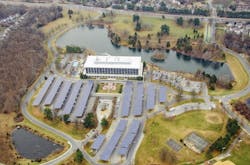Already on the map for its public service microgrids, Montgomery County is advancing into the next frontier of the technology — its nexus with transportation — with plans for a microgrid-ready depot to charge electric buses.
The Maryland county on Wednesday issued a solicitation seeking proposals for energy infrastructure to power electric buses at its Brookville Maintenance Facility in Silver Spring.
A neighbor to the nation’s capital, Montgomery County is Maryland’s most affluent and populated county. It’s also become a leader in microgrids, creating prototype contracts and development procedures for local governments to study and use.
A microgrid now operating at a public safety facility in Montgomery County, Maryland. Courtesy of Schneider Electric
Seeks public-private partnership
The county began exploring microgrids after a violent storm in 2012 knocked out power to 480,000 county residents for several days. Last year it activated two advanced microgrids at its Public Safety Headquarters and Correctional Facility. The microgrids were built in a public-private partnership with Duke Energy Renewables and Schneider Electric under an energy-as-a-service contract.
Now Montgomery County seeks to duplicate the approach. It’s in search of a partner to develop and help finance the smart depot using a minimum amount of county capital and leveraging tax credits, environmental credits and other incentives. The partner will design, build, finance, operate and maintain the smart energy facility.
Microgrid-ready and green
Like a growing number of jurisdictions, Montgomery County has set clean energy goals; it hopes to achieve zero greenhouse gas emissions by 2035. So it seeks clean — as well as resilient — resources to charge the electric buses.
In its request for proposals (RFP), the county says it envisions solar canopies over parking lots and conduit placement/infrastructure, energy storage, on-site natural gas generation, possible combined heat and power, and controls and electrical gear to integrate a future microgrid. Controls and other components may be used to regulate and monitor use of energy, shed demand and mobilize any on-site distributed energy or storage.
The RFP seeks compatibility with controls used on similar projects in the county — both Siemens Apogee and Schneider Electric’s EcoStruxure software are in operation.
If applicable, it may extend the eventual microgrid to neighboring facilities.
Join Microgrid Knowledge June 2-3 in Philadelphia for Microgrid 2020: Distributed Energy and World Electrification
Located on 17 acres, the transportation depot houses and services 200 county buses, as part of a 24/7/365 operation that uses power for lighting, space conditioning, data, on-site food preparations and communications.
The county already has developed infrastructure for the first 14 electric buses, which begin arriving this month. The new infrastructure will serve at least 56 additional electric buses.
Contract award expected this year
Pre-qualification proposals are due September 30 and final proposals October 30. The county expects to award a contract November 20 to the proposal that provides the greatest community benefit at the lowest annual operating costs.
The RFP is available on the county website.
Track news about microgrid RFPs. Subscribe to the free Microgrid Knowledge Newsletter.







